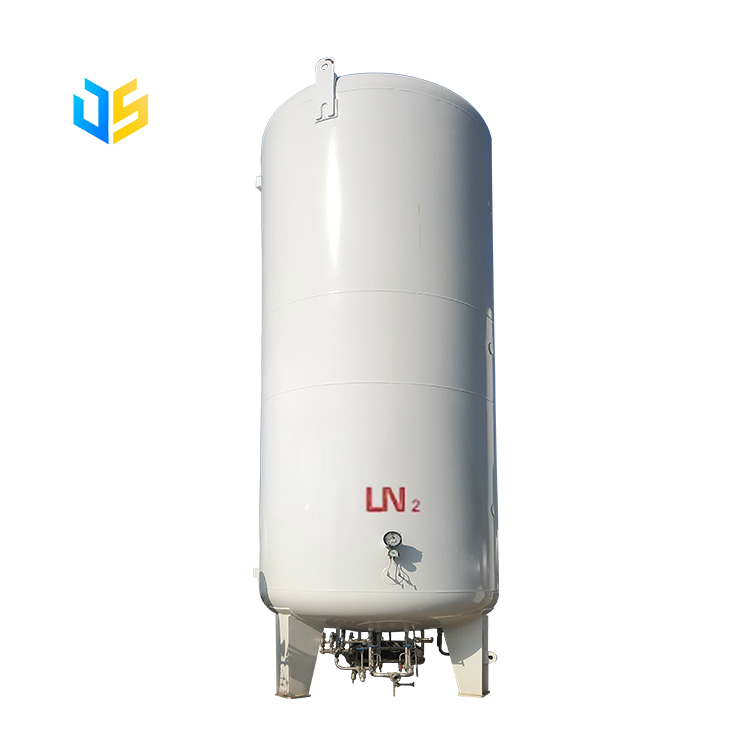Liquid Nitrogen Storage Tank
Liquid Nitrogen Storage Tank
Description
The Liquid Nitrogen Storage Tank features a double-walled cylindrical construction, consisting of an inner cylinder and tubes made of stainless steel S30408 and an outer jacket made of alloy steel Q245R. The space between the walls is filled with expanded perlite (also known as perlite sand), along with a specialized adsorbent that has been treated. Inside the tank, a high vacuum (0.5 to 6 Pa) is created, with a capacity of up to 200 m³. The tank operates at high working pressure (the working pressure of two tanks in four workshops is 2.0 MPa), and an external gasifier is installed to easily fill the tank and directly supply gas under pressure. Depending on their application, tanks are classified as stationary or mobile. Stationary tanks are primarily used for storing cryogenic liquids and are installed at production sites, usage points, or cryogenic liquid supply stations. Mobile tanks are designed for transporting low-temperature liquids from production sites or supply stations to usage points, often in the form of road or sea transport; these are referred to as tankers, trailers, or tankers. There are two types of installations: vertical (L) and horizontal (W).

Client Feedback from Brunei: Hospital cryogenic tank for storing oxygen with a capacity of five cubic meters.
Liquid Nitrogen Storage Tank
Features
Insulation Method: Powder Insulation
Working Pressure: 0.2-3.0 MPa
Useful Volume: 5 m³ - 200 m³
Design Temperature: -196 °C - -50 °C
Filling Percentage: 95%
Advantages
Vacuum powder insulation
Compact structure
Low daily evaporation rate
Small footprint
Centralized management
Safety and reliability
Easy operation and maintenance
Applications
Industrial Use: Production of nitric acid, synthetic ammonia, calcium cyanamide, explosives, etc.
Electrical Devices: Used in various electrical devices, food packaging, gas filling, thermal oxidation, epitaxial diffusion, chemical vapor deposition, and other processes for the preparation of semiconductor devices. Also used in gas chromatography.
Gas Extraction: Extraction of noble gases, cryogenic treatment of tools or parts, etc.
Protective Gas: Used as a protective gas for large integrated circuits, as a gas for filling lamps, etc.
Air and Oxygen Distribution
Cooling Agent: Used as a direct cooling agent for quick freezing of products; packaging gas (replacing residual air in packaging containers to extend shelf life).
Chemical Industry: Used in the production of ammonia, nitric acid, calcium cyanamide, hydrogen peroxide, etc. Pure nitrogen is used as a protective gas to prevent oxidation, evaporation, and combustion of substances, and as a gas for filling lamps. Liquid nitrogen is mainly used as a cooling agent for deep freezing of tools or parts and quick freezing of food, and is also used in low-temperature micro-grinding and electronics.
Agriculture, Medicine, Livestock, Refrigeration, and Electronics Industries: Used in metallurgy, chemical processing, mechanical processing, and other industries.
Production Process
Volume and Drawing Acquisition
Material Preparation and Cutting
Steel Plate Rolling
Welding Stainless Steel Plate
Assembly of Liquid Nitrogen Storage Tank
Filling Thermal Insulation Material Between Inner and Outer Tanks
Creating Vacuum in Storage Tank
RT and MT Inspection and Radiographic Inspection
Removal of Rust from Tank
Installation of Various Valves
Advantages
Adiabatic Performance: Selection of thermal insulation materials filled with perlite sand, vacuum, high-quality technology, unique filling process, quality guarantees ensure the best adiabatic effects. Surface anti-corrosion treatment undergoes sandblasting, rust removal, blowing, spraying, and other processes, and uses a two-component fast-curing liquid coating.
Safety Characteristics: The liquid nitrogen storage tank uses a "combined safety system," which includes two sets of safety valves working simultaneously. One side can be closed during regular safety valve inspections while the other side continues to operate, ensuring safe operation of the storage tank.
Management System: A manometer, differential level gauge, and level comparison table are installed on the top of the container in the liquid nitrogen storage tank, allowing real-time monitoring of the storage level and pressure changes, facilitating operations during filling and emptying.
Control System: Special vacuum gauges, vacuum manometers, and vacuum valves are installed at the bottom of the liquid nitrogen storage tank. They periodically or at any time test the vacuum degree in the interlayer space using a vacuum gauge to ensure safe operation of the storage tank.
Specifications
| No. | Model | Medium | Inner Tank Dimensions (Diameter x Thickness, mm) | Outer Tank Dimensions (Diameter x Thickness, mm) | Outer Dimensions (Diameter x Width, mm) | Gross Weight (kg) |
|---|---|---|---|---|---|---|
| 1 | JSSM5-L/0.8 Nitrogen | DN1400 | 2910 x 6 | 3550 x 8 | Φ1916x5262 | 3940 |
| 2 | JSSM10-L/0.8 Nitrogen | DN1800 | 3490 x 6 | 4100 x 8 | Φ2316x5965 | 6040 |
| 3 | JSSM15-L/0.8 Nitrogen | DN1800 | 5560 x 6 | 6170 x 8 | Φ2316x8035 | 8045 |
| 4 | JSSM20-L/0.8 Nitrogen | DN2200 | 4730 x 8 | 5340 x 10 | Φ2716x7361 | 9875 |
| 5 | JSSM30-L/0.8 Nitrogen | DN2400 | 6100 x 8 | 6780 x 10 | Φ2920x8881 | 14210 |
| 6 | JSSM50-L/0.8 Nitrogen | DN2700 | 8220 x 10 | 8970 x 10 | Φ3220x11222 | 21180 |
| 7 | JSSM5-L/1.6 Nitrogen | DN1400 | 2910 x 8 | 3550 x 8 | Φ1916x5229 | 4380 |
| 8 | JSSM10-L/1.6 Nitrogen | DN1800 | 3490 x 10 | 4100 x 8 | Φ2316x5965 | 6900 |
| 9 | JSSM15-L/1.6 Nitrogen | DN1800 | 5560 x 10 | 6170 x 8 | Φ2316x8035 | 9300 |
| 10 | JSSM20-L/1.6 Nitrogen | DN2100 | 5300 x 12 | 5950 x 10 | Φ2616x7933 | 11645 |
| 11 | JSSM30-L/1.6 Nitrogen | DN2400 | 6100 x 14 | 6780 x 10 | Φ2920x8881 | 16750 |
| 12 | JSSM50-L/1.6 Nitrogen | DN2700 | 8220 x 16 | 8970 x 10 | Φ3220x11187 | 25570 |
This is part of the model. We accept individual orders according to customer requirements.
Previous : Carbon Dioxide Storage Tanks
Next : Liquid Oxygen Storage Tank














Comments